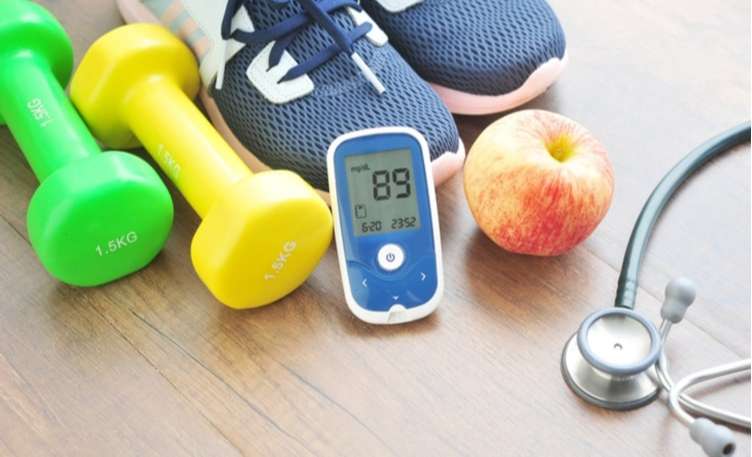Explore the powerful link between diabetes and exercise. Discover how physical activity can be your secret weapon in managing blood sugar levels, and find expert guidance on crafting your personalized exercise plan for a healthier life.
When it comes to diabetes, the role of exercise is often underestimated. In this comprehensive guide, we’ll unlock the secrets of how physical activity can be a game-changer in managing blood sugar levels and living a healthier life.

Diabetes Unveiled: Understanding the Challenge
Let’s kick things off with a little diabetes 101. Understanding the condition is crucial before we dive into the dynamic world of exercise and its impact on diabetes management.
What is Diabetes?
Diabetes is a chronic medical condition that affects how your body processes glucose, the primary source of energy for your cells. Glucose comes from the food you eat and is carried by your blood to your cells. However, in diabetes, there’s a glitch in this system.
The Two Major Types of Diabetes
- Type 1 Diabetes: In this autoimmune condition, the body’s immune system mistakenly attacks and destroys the insulin-producing beta cells in the pancreas. People with Type 1 diabetes require insulin injections or an insulin pump to survive.
- Type 2 Diabetes: The most common form of diabetes, Type 2, is characterized by insulin resistance. In this condition, the body doesn’t use insulin efficiently, and over time, the pancreas can’t produce enough insulin to keep blood sugar levels in check.
The Blood Sugar Rollercoaster
Blood sugar, or glucose, is a critical player in this story. When your blood sugar is too high, it can damage blood vessels and nerves, leading to a range of complications. When it’s too low, you may experience hypoglycemia, which can be life-threatening.
The Connection Between Exercise and Diabetes
Exercise and diabetes have a powerful link, like a dynamic duo working together to maintain healthy blood sugar levels. When you engage in physical activity, your muscles use glucose for energy, which can lower blood sugar levels.
How Exercise Benefits Diabetes
- Insulin Sensitivity: Exercise enhances the body’s sensitivity to insulin, helping it transport glucose into cells more effectively.
- Glucose Regulation: Regular physical activity helps regulate blood sugar, preventing dangerous spikes and drops.
- Weight Management: Exercise contributes to weight loss or maintenance, which can be essential for managing Type 2 diabetes.
- Heart Health: Exercise is a heart-healthy practice, crucial for people with diabetes who are at a higher risk of cardiovascular issues.
- Stress Reduction: Physical activity can reduce stress, which, in turn, can help control blood sugar levels.
The Role of Exercise in Type 1 Diabetes
Type 1 diabetes and exercise require a bit of extra planning and attention. While it’s perfectly possible to stay active with Type 1 diabetes, there are unique considerations to keep in mind:
- Insulin Adjustments: You may need to adjust your insulin regimen to accommodate exercise. Working with your healthcare team is essential to fine-tune these adjustments.
- Hypoglycemia Risk: Vigilance is crucial to prevent low blood sugar during or after exercise. Carry fast-acting carbohydrates for emergencies.
- Monitor Blood Sugar: Regularly check your blood sugar levels before, during, and after exercise to ensure they remain within a safe range.
Exercise and Type 2 Diabetes: A Winning Combo
For those with Type 2 diabetes, exercise can be a game-changer. It can improve your overall health, help manage your blood sugar, and reduce the need for medication. Here’s how you can benefit from physical activity:
Cardiovascular Exercise: Engaging in activities like walking, jogging, cycling, or swimming can strengthen your heart, lower blood pressure, and improve your body’s ability to use insulin.
Strength Training: Building muscle can increase your metabolism, which is helpful for weight management. It can also enhance your body’s insulin sensitivity.
Flexibility and Balance Exercises: These are particularly important for older adults with diabetes, as they can help prevent falls and fractures.
Daily Movement: Make a conscious effort to move more throughout the day. Simple actions like taking the stairs instead of the elevator or doing light housework can add up.
Crafting Your Personalized Exercise Plan
Now that you understand the connection between diabetes and exercise, it’s time to create a plan that works for you. Your exercise routine should align with your fitness level, preferences, and health goals.
Set Clear Goals: Determine what you want to achieve with your exercise plan. Whether it’s blood sugar control, weight loss, improved fitness, or all of the above, having clear goals keeps you motivated.
Choose Enjoyable Activities: Find exercises you enjoy. This increases the likelihood that you’ll stick with your plan in the long run. It could be dancing, hiking, swimming, or even gardening.
Start Slowly: If you’re new to exercise, begin slowly and gradually increase the intensity and duration of your workouts. This prevents overexertion and minimizes the risk of hypoglycemia.
Consistency is Key: Consistency is more important than intensity. Regular, moderate exercise often yields better results than occasional intense workouts.
Listen to Your Body: Pay attention to how your body responds to exercise. If you experience dizziness, extreme fatigue, or any unusual symptoms, stop exercising and seek medical advice.
Stay Hydrated: Dehydration can affect your blood sugar levels. Drink plenty of water before, during, and after your workouts.
Consider Medical Clearance: If you have any underlying health concerns, consult with your healthcare provider before starting a new exercise program.
FAQs: Your Burning Questions Answered
Q1: How often should I exercise to manage my blood sugar levels?
A: Aim for at least 150 minutes of moderate-intensity aerobic exercise or 75 minutes of vigorous-intensity exercise per week, spread over at least three days.
Q2: Can I exercise even if I’m overweight or have other health conditions?
A: Absolutely. Exercise can benefit everyone, regardless of weight or other health conditions. It’s essential to choose activities that suit your fitness level.
Q3: What’s the best time to exercise for managing blood sugar levels?
A: The timing can vary from person to person. Some people find it helpful to exercise in the morning to kickstart their metabolism, while others prefer evenings. Test what works best for you.
Q4: Are there specific foods I should eat before and after exercising with diabetes?
A: It’s advisable to consume a balanced meal or snack before exercise to help stabilize blood sugar levels. After exercise, focus on recovery with a combination of protein and carbohydrates.
Q5: Can I exercise during hypoglycemia (low blood sugar)?
A: No, it’s essential to treat low blood sugar promptly before exercising to prevent complications.
In Summary: Taking Charge of Your Diabetes with Exercise
Diabetes and exercise are like two pieces of a puzzle that fit together perfectly. With the right approach to physical activity, you can take charge of your blood sugar levels and improve your overall health. Remember, it’s not about running marathons or lifting heavy weights; it’s about finding an exercise routine that suits your lifestyle and health goals.
So, lace up those sneakers, grab your water bottle, and take the first step toward a healthier, more active life. With exercise as your ally, you can unlock the secret to managing diabetes and achieving a higher quality of life.
Explore these external links to learn more about diabetes and exercise:
- American Diabetes Association: Exercise and Type 2 Diabetes
- Joslin Diabetes Center: Exercise and Type 1 Diabetes
- CDC: Physical Activity and Diabetes
- WebMD: Diabetes and Exercise
- The Healing Power of Exercise: Battling Depression and Mental Health Recovery
- Harvard Health: Exercise and Type 2 Diabetes





